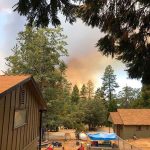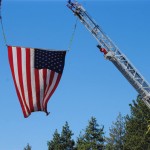By John R. Hawkins
Fire Chief & Operational Area Fire & Rescue Coordinator
Cal Fire/Riverside County Fire Department
Editor’s note: Chief Hawkins uses an imaginary, but realistic, scenario to describe the thought process and actions of an incident commander during a fire on the Hill. This is a series of articles explaining how a fire officer assesses, strategizes and tactically implements an incident action plan to combat a rapidly escalating, life-threatening wildland fire. The first two ran in the June 22 and June 29 issues. Hawkins takes you into the strategic mind of a fire officer as he develops the story. This article further explains what happens at a major wildland fire.
We left you a few weeks ago with a rapidly spreading wildland fire that started about 12:30 p.m. on the north side of Highway 74 near the Strawberry Creek Bridge. At about 2 p.m., the fire had grown over 300 acres and was less than half a mile below the town of Idyllwild near Double View Drive and the overlook. Firefighters had engaged in perimeter control and structure defense efforts.
The fire was a legitimate threat to life and property in Idyllwild, Mountain Center and Pine Cove. The U.S. Forest Service’s San Bernardino National Forest, Cal Fire/Riverside County Fire Department, Idyllwild Fire Protection District, Riverside County Sheriff’s Department and the California Highway Patrol entered unified command and moved the Incident Command Post to Mountain Center. Initial efforts were focused on securing the fire perimeter.
Most importantly for fire officials was safely and effectively evacuating civilians and defending structures in the fire’s path while developing an operational attack organization and supporting planning logistical organizations.
To best imagine the location of the fire scenario, picture yourself standing on Highway 74 near the Strawberry Creek Bridge about 5 miles west of Mountain Center. You are looking up the hill at an escalating brush fire. The left flank is referred to as Division A, while the right flank is Division Z and the area where the fire is hitting the rim is called Division F.
Your view is extremely troubling because you know the fire is soon to hit the structures on the rim. Air tankers are dropping aerial fire retardant along the rim hopefully to hold the fire at the edge short of the structures. The smoke being generated off the fire is rising to probably over 20,000 feet.
You know, even as a non-firefighter, that this fire is a serious threat to life and property. You hope firefighters and law enforcement officers can do their jobs to evacuate civilians and save property.
As was briefly mentioned during the last article, evacuation efforts were being planned and initially executed by the Riverside County Sheriff’s Department. The County Emergency Management Department coordinates the evacuation with the community and responders. It works with the responders to set evacuation trigger points (typically a geographical point or points) and to define where evacuees should exit the community and where relocation centers will be located.
It knows from pre-planning how many evacuees can be housed at each center, and how to feed and medically care for those with health needs. It will document who is at each evacuation center. That information will be made available at off-site locations for family members to locate their next of kin, etc. EMD also will work with the Sheriff’s Department to define which exit route evacuees should take in order to avoid conflict with incoming emergency responders.
It may not always be possible to separate inbound emergency vehicle traffic from outbound evacuees. In that case, careful traffic control must be implemented. Although this fire scenario calls for evacuating the impacted residents, another scenario might call for sheltering the residents in place.
Also working with the command will be Riverside County Animal Services. It will work hard to ensure the evacuation of animals and equestrians. Animal Services has pre-planned procedures and facilities for the re-location of animals. It works closely with private animal organizations.
The complexity of the fire coupled with the impact to mountain residents leads EMD to open the County Emergency Operations Center. The EOC coordinates activities for the Riverside County Operational Area, works with all agencies to best coordinate needs and prioritizes the assignment of resources to any competing incidents. Here, EMD works hard to ensure displaced residents are properly relocated to centers and receive the correct assistance. During the initial phase of the fire, Riverside County Fire will file a Fire Management Assistance Grant request with CalOES seeking both state and federal after-fire fiscal assistance.
During the first afternoon with the seriously emerging fire significantly threatening Idyllwild, Mountain Center and Pine Cove, the incident commanders order an Incident Management Team. The team arrives with members who train together and work well together during the most difficult of emergency situations. The team incorporates all the components of the IC System, including the general staff (IC and operations, planning, logistics and finance section chiefs), the command staff (information, liaison and safety officers) and the necessary staff members to establish a field command post and logistical base at Garner Valley, a helibase at Thomas Ranch in Garner Valley and a media contact center probably near Valle Vista, in the east Hemet area. The team will not usurp local fire and law enforcement agencies.
Firefighters work extended work shifts, typically 12 to 24 hour operational periods, with the same time resting while off shift. An Incident Action Plan will be developed for each operational period. The support facilities will be deliberately located out of the fire area to ensure not being impacted by the fire.
While support facilities and activities are occurring in the background, fire officers and firefighters ensure continuity of operations across all clocks. Field fire commanders do their best to protect life and property, defining their overriding goals for public protection while always factoring the safety of residents and firefighters into their game plans. Often, this is not easy; firefighting is a dangerous job that leaves firefighters tired, hungry and dirty, sometimes for extended periods.
Those fire commanders on the fire line or in positions to defend structures (life and property) are always balancing their SITSTAT (situation status) with their RESTAT (resource status) currently and for the future, which might be a projected period of three hours, six hours, 12 hours, three days or more. Early on, division supervisors call for more resources to effect perimeter control and defend structures. They will be planning and submitting information for the next operational period as to their projected SITSTAT (what they want to accomplish) and RESTAT (resources they will need to effect the tactical needs).
Engine strike teams (five engines and a leader) are deployed for structure defense. Many engine strike teams will be needed. Crew strike teams (30 firefighters, including a leader) are assigned to perimeter control efforts, often in the most remote, steep and rugged terrain. Fire crews are truly the infantry of the wildland fire service. Field commanders constantly monitor the weather, particularly the dry bulb temperature, relative humidity, and wind direction and speed. Weather conditions change throughout the day and throughout the fire. Weather, particularly wind, is the most changing and driving fire force.
Every 12 hours during a 12-hour operational period, the IMT holds a planning meeting. They compare actual accomplishments or tactical results with planned activities. The planning reaffirms the incident objectives as were explained earlier or revise objectives based on changing conditions. Unified command of fire and law enforcement actions will occur. Fire subordinates, particularly within the Operations Section, propose tactical actions for each part of the fire. Those geographical locations are often referred to as branches or divisions.
In addition to proposing what actions to apply, subordinates propose how many and what kind and type of resources will be assigned to each field branch of division. In the end, they will recommend what and how it must be done but the IC has the final word as to the strategy and tactics. All this tactical information, along with evacuation information, safety information, weather and fire behavior information, communication frequencies, air operations and logistical support, is incorporated into each 12-hour operational period IAP. The IAP becomes the field operating and support bible for the fire.
Critically important at every fire is full involvement of the community. Involvement is best accomplished by early, and as accurate as possible, news releases and social media postings, frequent news conferences to ensure the media gets the best, most accurate fire situation updates and the holding of informative community meetings. Every IC always factors effective, transparent information dissemination into his or her incident actions.
Let us return to the details of the scenario. Overnight, the fire ran over the ridge into residential areas. The fire destroyed several structures although a count is not yet available. No civilians were injured or killed nor were firefighters seriously injured or killed. Firefighters strongly stood the test of structure defense and have basically stopped the forward spread of the fire. For today, firefighters both ground- and air-based must hold the fire at its current location. If the fire can be held for two days, chances are good the fire will not destroy any more of the community. Much fire mop-up or overhaul of hot spots must happen. Electrical service and propane service must be checked. The IMT hopes to allow residents to return to their homes within a day, although that timing is not certain.
Well, the fire scenario is over and, although the fire story was destructive, it was not as bad as it could have been. The true tipping point in favor of less damage was the changing weather over the first night.
After the fire ended, EMD and fire services conducted a survey of the damaged area. An after-action review is conducted by the responding agencies. They will determine what went well and what can be improved. Those determinations will be factored into operational aspects for future fires. An After Action Report will be published.
John Hawkins is the fire chief for the Cal Fire Riverside Unit and Riverside County Fire Department. He is entering his 54th year with Cal Fire and has served as the fire chief for going on 11 years. Chief Hawkins values leadership, fire and life safety and community involvement. He has been involved with the Riverside County Mountain Area Fire Safety Task Force since 2004. He served as the Cal Fire IC at the 2003 Cedar Fire in San Diego County. The Cedar Fire remains the largest and most destructive in California history.










